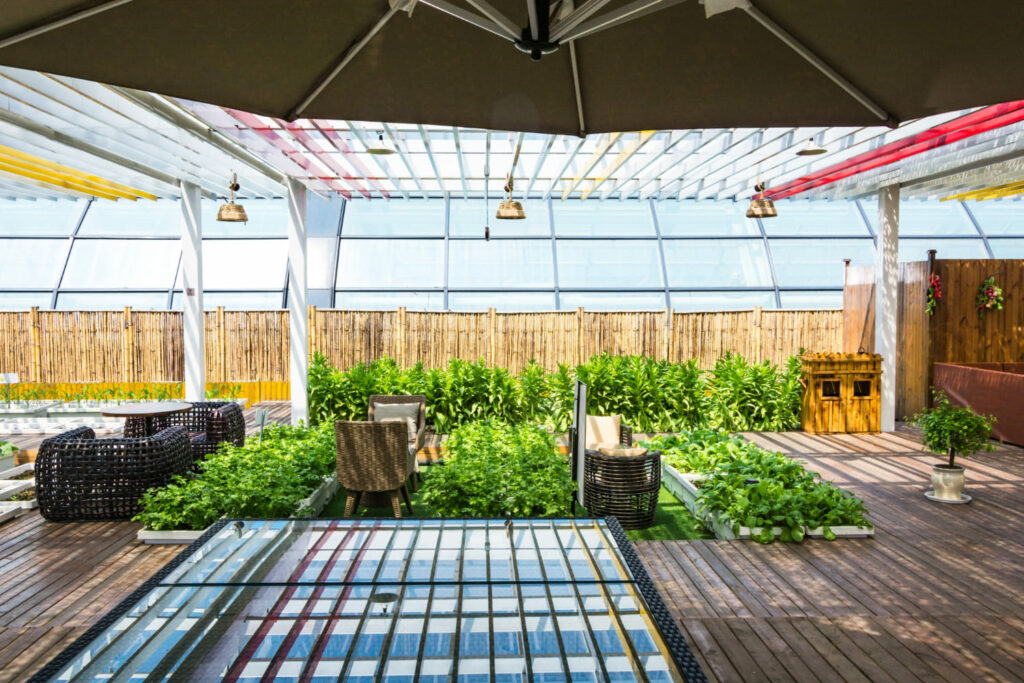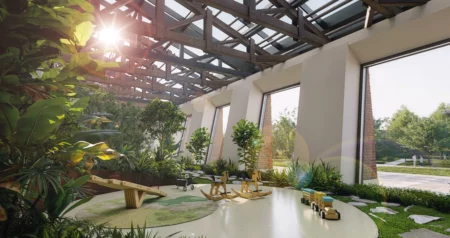In the quest for sustainable and aesthetically pleasing home decor, rooftop gardens have emerged as a popular choice for eco-conscious individuals. Designing and maintaining a beautiful eco-friendly rooftop garden requires careful planning, knowledge, and a commitment to sustainable practices.
Rooftop gardens have a long history and can be traced back to various cultures around the world. The concept of cultivating plants on rooftops has evolved over centuries, influenced by practical, cultural, and environmental considerations.
In the 19th century, rooftop gardens gained popularity in Victorian England. The Victorians were known for their interest in ornate gardens, and some affluent individuals began to create rooftop gardens as extensions of their homes.
This comprehensive guide will walk you through the steps to create your green oasis atop your home. We will also go through the advantages of rooftop gardens.
Section 1: Planning Your Rooftop Garden
1. Assessing Structural Capacity:
Before diving into the world of rooftop gardening, it’s crucial to evaluate your roof’s structural capacity. Rooftop gardens can be heavy, and it’s crucial to ensure your roof can bear the load.
A standard extensive green roof, with lightweight soil and plants, typically weighs around 15-50 pounds per square foot. Consult with a structural engineer to ensure that your rooftop can support the additional weight of the garden, soil, and plants.
2. Sunlight and Wind Exposure:
Consider the sunlight and wind exposure your rooftop receives throughout the day. Full sun typically means six or more hours of direct sunlight each day, while partial sun or shade implies fewer hours.
Observe your rooftop’s sunlight patterns throughout the day and consider this when choosing plants. Wind exposure can also affect plant health; wind-tolerant plants like sedums are suitable for windy rooftops.
3. Budgeting and Material Selection:
Establish a realistic budget for your rooftop garden project. Research sustainable and weather-resistant materials for containers, decking, and irrigation systems. Recycled and reclaimed materials can add an eco-friendly touch to your design.
Green roofs can have upfront costs, but they often provide long-term benefits. According to the Green Roofs for Healthy Cities organization, a well-designed green roof can last two to three times longer than a conventional roof.
Section 2: Designing Your Eco-Friendly Rooftop Garden
1. Container Gardening:
Container gardening allows for flexibility and mobility. Containers made from recycled plastic or composite materials are lightweight, durable, and eco-friendly.
Ensure containers have drainage holes to prevent waterlogging. Elevating containers on platforms or using hanging containers maximizes space and provides better air circulation for plant roots.
2. Native and Drought-Tolerant Plants:
Choose native plants and varieties that are well-suited to your region’s climate. Drought-tolerant plants not only conserve water but also require less maintenance. Research native plants for your region and select those with low water needs. Native plants also support local biodiversity and are better suited to resist pests and diseases.
3. Vertical Gardening:
Vertical gardening is an efficient use of space. Green walls or trellises with climbing plants can provide shade, improve air quality, and reduce the urban heat island effect.
Explore vertical gardening options such as modular green wall systems or trellises for vining plants. This not only enhances aesthetics but also adds a vertical dimension to your garden.
4. Green Roof Systems:
Green roof systems offer insulation benefits, reducing energy consumption. According to a study published in the Energy and Buildings journal, green roofs can contribute to a building’s energy efficiency by providing natural insulation.
Consider modular green roof systems that consist of layers like a waterproof membrane, drainage layer, growing medium, and vegetation. These systems promote biodiversity, absorb rainwater, and contribute to a cooler environment.
Section 3: Implementing Sustainable Practices
1. Rainwater Harvesting:
Rainwater harvesting reduces the demand for municipal water supplies. According to the U.S. Environmental Protection Agency (EPA), a well-designed rainwater harvesting system can meet almost all non-potable water needs for a household.
A rainwater harvesting system to collect and store rainwater for irrigation. This sustainable practice conserves water resources and reduces your reliance on traditional water sources.
2. Composting:
Establish a composting system for kitchen scraps and garden waste. Compost enriches the soil, enhances plant health, and reduces the need for chemical fertilizers.
3. Integrated Pest Management:
Embrace integrated pest management techniques to minimize the use of chemical pesticides. Companion planting and natural predators can help control pests in an eco-friendly way.
Section 4: Maintenance Tips for an Eco-Friendly Rooftop Garden
1. Regular Inspections:
Conduct regular inspections of your rooftop garden to identify any structural issues, drainage problems, or signs of plant diseases. Addressing issues promptly can prevent more significant problems in the long run.
2. Seasonal Care:
Adjust your maintenance routine based on the seasons. Prune plants, replenish soil nutrients, and protect sensitive plants during extreme weather conditions.
3. Sustainable Fertilization:
Choose organic and slow-release fertilizers to nourish your plants without harming the environment. Consider using compost as a natural soil amendment.
Advantages of Rooftop Gardens
Rooftop gardens, also known as green roofs, offer a range of advantages that extend beyond aesthetics. Here are some key benefits of rooftop gardens:
Environmental Benefits:
- Temperature Regulation: Green roofs act as natural insulators, reducing the urban heat island effect by absorbing and deflecting sunlight. This helps regulate temperatures in both the building and the surrounding area.
- Air Quality Improvement: Plants on rooftops absorb pollutants and release oxygen, contributing to improved air quality. This is particularly valuable in urban environments with high levels of air pollution.
- Stormwater Management: Green roofs absorb rainwater, reducing the risk of runoff and alleviating pressure on stormwater drainage systems. This helps prevent flooding and minimizes soil erosion.
Energy Efficiency:
- Cooling Effect: The insulation provided by green roofs can reduce the need for air conditioning in hot weather, leading to lower energy consumption and costs.
- Reduced Energy Demand: By moderating indoor temperatures, green roofs contribute to energy efficiency in buildings, leading to lower heating and cooling demands.
Biodiversity and Habitat Creation:
- Ecological Diversity: Rooftop gardens can serve as habitats for birds, insects, and other small animals, promoting biodiversity in urban areas.
- Support for Pollinators: Planting a variety of flowering plants can attract pollinators such as bees and butterflies, supporting local ecosystems and contributing to the health of surrounding green spaces.
Aesthetic and Recreational Benefits:
- Visual Appeal: Rooftop gardens enhance the aesthetic appeal of buildings, providing green spaces in urban environments and softening the visual impact of structures.
- Recreational Spaces: Well-designed rooftop gardens can be used as recreational areas, offering residents or employees a peaceful and green space to relax and unwind.
Extended Roof Lifespan:
- Protection from UV Rays: The vegetation and growing medium on green roofs act as a protective layer, shielding the roof membrane from harmful UV rays. This can extend the lifespan of the roof by reducing the effects of weathering.
Sound Insulation:
- Noise Reduction: The soil and plants on green roofs absorb and dampen sound, providing a degree of insulation against outdoor noise. This is particularly valuable in urban settings with high levels of ambient noise.
Increased Property Value:
- Desirability and Market Value: Properties with rooftop gardens are often considered more desirable, potentially increasing their market value. The aesthetic and environmental benefits can make a property stand out in a competitive real estate market.
Sustainable Land Use:
- Optimal Use of Space: Rooftop gardens make efficient use of underutilized space in urban areas, contributing to sustainable land use practices without sacrificing valuable ground space.
Challenges of Rooftop Gardens and Their Solution:
While rooftop gardens offer numerous benefits, they also come with certain challenges that need to be addressed for successful implementation and maintenance. Here are some common challenges associated with rooftop gardens:
Structural Load and Integrity:
- Challenge: Rooftop gardens add additional weight to the structure. Ensuring that the building’s structure can support the load is a critical consideration.
- Solution: Conduct a structural analysis to determine the load-bearing capacity of the roof. Reinforcements may be necessary, especially for extensive green roofs with deeper soil.
Waterproofing and Leakage:
- Challenge: Water leakage can occur if the waterproofing membrane is not properly installed or if it deteriorates over time.
- Solution: Invest in high-quality waterproofing systems and ensure proper installation. Regular inspections and maintenance can help identify and address potential leaks early on.
Plant Selection and Maintenance:
- Challenge: Not all plants are suitable for rooftop environments due to exposure to wind, sunlight, and limited soil depth. Maintenance can be challenging, especially for inaccessible roofs.
- Solution: Choose drought-tolerant and wind-resistant plants suitable for rooftop conditions. Implement a maintenance plan that includes regular inspections, pruning, and soil replenishment.
Irrigation:
- Challenge: Rooftop gardens may face water scarcity and uneven irrigation, leading to stress on plants.
- Solution: Install efficient irrigation systems, such as drip irrigation, and consider rainwater harvesting. Monitor soil moisture levels and adjust irrigation schedules accordingly.
Temperature Extremes:
- Challenge: Rooftops are exposed to temperature extremes, with elevated temperatures in summer and potential frost in winter.
- Solution: Choose plants that can tolerate a range of temperatures. Implement shading techniques, use reflective materials, and provide insulation to protect plants during extreme weather conditions.
Wind Exposure:
- Challenge: Rooftops are often exposed to strong winds, which can damage plants and increase water evaporation.
- Solution: Install windbreaks, such as trellises or barriers, to protect plants. Select wind-resistant plant varieties, and consider the use of windbreak plants to create a microclimate.
Access and Safety:
- Challenge: Accessing rooftop gardens for maintenance can be challenging and may pose safety concerns.
- Solution: Ensure safe and secure access points for maintenance activities. Consider installing safety features such as guardrails and ladders.
Permitting and Regulations:
- Challenge: Local regulations and building codes may impose restrictions on the installation of rooftop gardens.
- Solution: Obtain necessary permits and approvals before starting a rooftop garden project. Work closely with local authorities to ensure compliance with regulations.
Costs:
- Challenge: Initial setup costs for rooftop gardens can be relatively high, especially if structural modifications are required.
- Solution: Develop a realistic budget, considering factors such as structural assessments, materials, and installation. Long-term benefits, including energy savings, increased property value, and environmental advantages, can offset initial costs.
Limited Space:
- Challenge: Rooftop gardens often have limited space, requiring careful planning for optimal utilization.
- Solution: Embrace vertical gardening techniques, use space-efficient containers, and prioritize plants that can thrive in confined areas.
Conclusion:
Designing and maintaining a beautiful eco-friendly rooftop garden is a rewarding endeavor that combines creativity with sustainability. By following the practical tips outlined in this guide, you can create a thriving green space that enhances your home’s aesthetic appeal while contributing to a healthier planet. Remember to adapt your design and maintenance practices to suit your specific rooftop conditions and enjoy the numerous benefits of your sustainable oasis.









